

SAMR Model - EdTech Training. SAMR. SAMR and Bloom's Taxonomy — Ed Tech Today. Substitution activities are those where a digital resource or object replaces an analogue on.
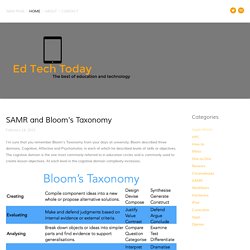
A commonly cited example is the use of a word processor to type a story instead of writing it or using flash cards on screen instead of their physical equivalent. Augmented activities use features of technology to improve a task, but are still fundamentally unaltered from their analogue equivalents. For example using the spell check in word processor or getting immediate feedback in drill and practice. Above the dotted line in the diagram tasks take on a complexity not otherwise achievable.
Modification tasks, for example, might include recording and editing a movie, or creating a digital storybook after listening to an eBook with text to speech. The Big Tech Coach Blog: The importance of TPACK, SAMR and the Four Cs. As Instructional Technology Coaches, we must always be working with our teachers to ensure that they are effectively integrating technology with their pedagogy and content.

We know that effective integration can have positive results but even experienced teachers often struggle with how to do this. It should start in their preservice program, but many great teachers make it into the classroom with little background in integrating technology. The framework that provides the basis for effective integration is TPACK. Technological, Pedagogical and Content Knowledge. Published on May 28th, 2013 | by Mark Anderson Technology, Pedagogy, & Content Knowledge model Technological, Pedagogical and Content Knowledge.
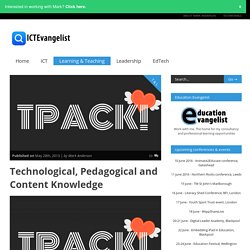
TPACK in 3 Minutes. TPACK Explained. Technological Pedagogical Content Knowledge (TPACK) attempts to identify the nature of knowledge required by teachers for technology integration in their teaching, while addressing the complex, multifaceted and situated nature of teacher knowledge.
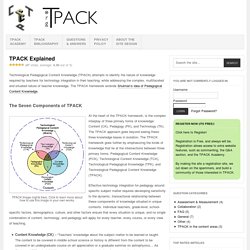
The TPACK framework extends Shulman’s idea of Pedagogical Content Knowledge. The Seven Components of TPACK TPACK Image (rights free). Click to learn more about how to use this image in your own works. At the heart of the TPACK framework, is the complex interplay of three primary forms of knowledge: Content (CK), Pedagogy (PK), and Technology (TK). Effective technology integration for pedagogy around specific subject matter requires developing sensitivity to the dynamic, transactional relationship between these components of knowledge situated in unique contexts.
Content Knowledge (CK) – “Teachers’ knowledge about the subject matter to be learned or taught. SAMR and Bloom's Taxonomy: Assembling the Puzzle. Note: If you aren't familiar with SAMR, check out our video Introduction to the SAMR Model.
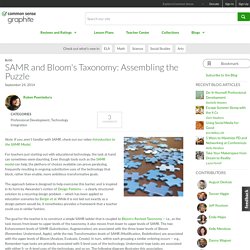
For teachers just starting out with educational technology, the task at hand can sometimes seem daunting. Even though tools such as the SAMR model can help, the plethora of choices available can prove paralyzing, frequently resulting in ongoing substitutive uses of the technology that block, rather than enable, more ambitious transformative goals.
The approach below is designed to help overcome this barrier, and is inspired in its form by Alexander’s notion of Design Patterns -- a clearly structured solution to a recurring design problem -- which has been applied to education scenarios by Bergin et al. While it is not laid out exactly as a design pattern would be, it nonetheless provides a framework that a teacher could use in similar fashion. Bloom Your Lessons Plans With An iPad: The Pedagogy Wheel - Practutor Blog. How to judge an educational app pedagogically?
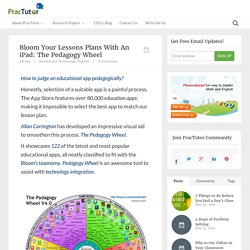
Honestly, selection of a suitable app is a painful process. The App Store features over 80,000 education apps; making it impossible to select the best app to match our lesson plan. Allan Carrington has developed an impressive visual aid to smoothen this process. The Pedagogy Wheel. It showcases 122 of the latest and most popular educational apps, all neatly classified to fit with the Bloom’s taxonomy. In Support of Excellence. Fourni par Traduction DOWNLOAD THE LATEST VERSION: V4 published Mar 2015.
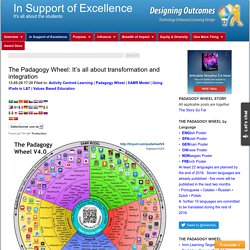
This PDF Poster has links to 122 of the latest and most popular educational apps. Now these resources are available in 19 different languages. The poster also has app selection criteria according to Blooms taxonomy. V4.0 was published in March 2015 but I knew I was onto something useful when I first put the Padagogy Wheel together in July 2012. So why the need for Version 2.0? New Padagogy Wheel Helps You Integrate Technology. Sometimes a visual guide comes along and it just makes total sense.

That’s how I felt about Allan Carrington’s clever ‘Padagogy Wheel‘ which we featured on Edudemic last week. Check out the previous version then view the one below to see the differences. From what I can tell, putting the wheel on this site has generated a bit of buzz and I’m glad we could help spread the knowledge. But I was quite amazed this morning when I saw that the Padagogy Wheel had been updated. Now at version 2.0, it features another band around the edge focusing on the SAMR Model and on helping teachers (and admins) effectively integrate education technology. This new Padagogy Wheel (which honestly is less about iPads and more about technology integration now) should encourage you to focus on redefining your current standards, the current role tech plays in your classroom, and just about everything else. Push My Thinking: TPACK or SAMR or ? – ED TECH COACHING. **Update 4/26/14: I LOVE the responses to this post; they made me consider a lot of different ways of looking at TPACK and SAMR, and really stretched my thinking.

If you read this post, also read the comments- and check out the links that some people have included! CLO. SAMR MODEL w/ history example. Why Integrate Technology into the Curriculum?: The Reasons Are Many. VIDEO: An Introduction to Technology Integration Running Time: 5 min.

Technology is ubiquitous, touching almost every part of our lives, our communities, our homes. LearningTechnologySAMRModel. PadWheel Poster V4. The SAMR model: engage in deep learning and authentic contexts. Issue 7 Do you leverage technology to plan and implement highly effective learning that was previously inconceivable in traditional classrooms? Effective learning in any environment requires good design, management and pedagogy. SAMR. Resources. Google Classroom : Student View. The SAMR Model Explained By Students. SAMR in 120 Seconds. SAMR model / Teacher inquiry / Professional learning. The Substitution Augmentation Modification Redefinition (SAMR) model, developed by Dr. Ruben Puentedura, offers a method of seeing how computer technology might impact teaching and learning. It shows a progression that adopters of educational technology often follow as they progress through teaching and learning with technology.
It is a framework through which teachers can assess and evaluate the technology used in the classroom. As teachers move along the continuum, computer technology becomes more important in the classroom but at the same time becomes more invisibly woven into the demands of good teaching and learning. EdofICTJSSALC - SAMR Examples. The following examples are ways to examine the progress from S to R. Using SAMR to Teach Above the Line - Getting Smart by Susan Oxnevad - 1:1 program, Apple, edchat, EdTech, SAMR, technology. For as long as I can remember I have been an advocate for helping teachers understand the stages of technology integration to help them effectively use tech as a tool for learning. I’ve adopted a few different tech integration models over the years, discussed the ideas with administrators for use as a starting point for tech integration, and kept the ideas front of mind as I invent and discover new ways for using technology as a tool for learning.
Discussing the stages of tech integration has led to some thought provoking and inspiring conversations, but the ideas have not gained a lot of momentum in my face-to-face teaching environment until now. As many districts jump on board with 1:1 implementation, Apple’s use of the SAMR model as a framework for tech integration presents a consistent, clear and powerful message that is spreading! About SAMR Researchers have determined that technology integration typically moves through specific levels. Image created by Dr. SAMR/TPACK. 8 Examples of Transforming Lessons Through the SAMR Cycle.
The SAMR Model for integrating technology into teaching, developed by Dr. Ruben Puentedura, has gained a good deal of exposure in recent years. “SAMR” is an acronym that stands for Substitution, Augmentation, Modification, and Redefinition. SAMR Model Explained for Teachers. Introduction to the SAMR Model Video. SAMR. SAMR Model - Technology Is Learning. OSAPAC / CCPALO. Beyond SAMR: The Teacher’s Journey To Technology Integration. The SAMR model (substitution, augmentation, modification and redefinition) explores the impact of integrating technology on both teaching and learning. It attempts to outline a progression that educators follow in their journey towards redefining teaching and learning with technology. I’ve used this model as a guide to identify where a particular lesson or activity falls on the spectrum of technology integration, but it does not reflect the teacher’s evolution.
In professional development, it’s common to hear teachers groan, “I’m so behind. There’s so much to learn. I won’t ever catch up.” Levels of Implementation-SAMR - Laptops and Learning. Technology Integration Matrix. Digital vs Digitized Learning. As teachers begin to shift toward greater personalized learning experiences for students, their initial steps build upon what they already know from face-to-face instruction.